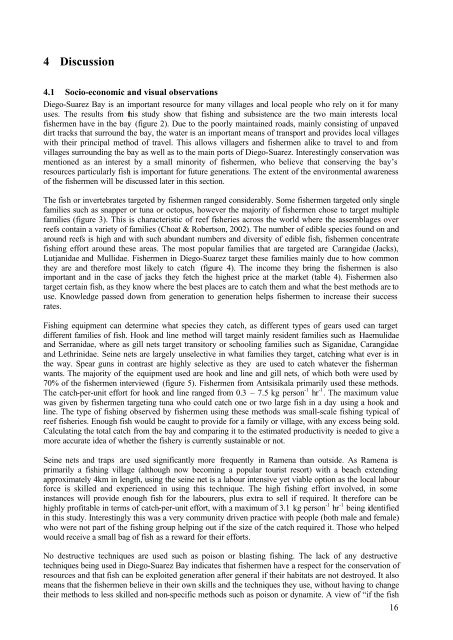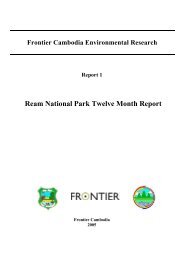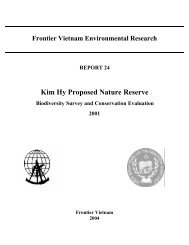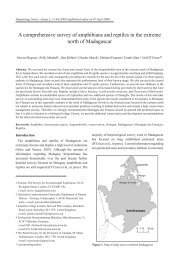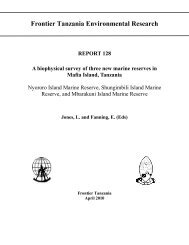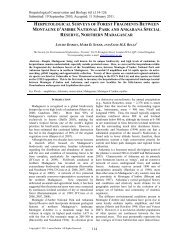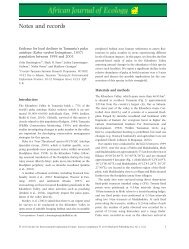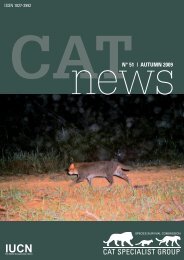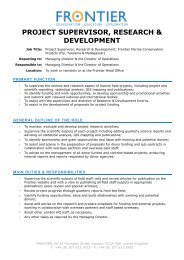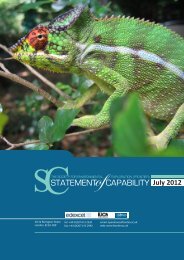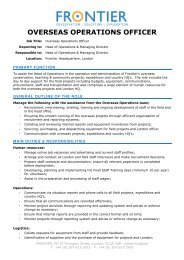An assessment of local fisheries in Diego-Suarez Bay, Madagascar
An assessment of local fisheries in Diego-Suarez Bay, Madagascar
An assessment of local fisheries in Diego-Suarez Bay, Madagascar
Create successful ePaper yourself
Turn your PDF publications into a flip-book with our unique Google optimized e-Paper software.
4 Discussion<br />
4.1 Socio-economic and visual observations<br />
<strong>Diego</strong>-<strong>Suarez</strong> <strong>Bay</strong> is an important resource for many villages and <strong>local</strong> people who rely on it for many<br />
uses. The results from this study show that fish<strong>in</strong>g and subsistence are the two ma<strong>in</strong> <strong>in</strong>terests <strong>local</strong><br />
fishermen have <strong>in</strong> the bay (figure 2). Due to the poorly ma<strong>in</strong>ta<strong>in</strong>ed roads, ma<strong>in</strong>ly consist<strong>in</strong>g <strong>of</strong> unpaved<br />
dirt tracks that surround the bay, the water is an important means <strong>of</strong> transport and provides <strong>local</strong> villages<br />
with their pr<strong>in</strong>cipal method <strong>of</strong> travel. This allows villagers and fishermen alike to travel to and from<br />
villages surround<strong>in</strong>g the bay as well as to the ma<strong>in</strong> ports <strong>of</strong> <strong>Diego</strong>-<strong>Suarez</strong>. Interest<strong>in</strong>gly conservation was<br />
mentioned as an <strong>in</strong>terest by a small m<strong>in</strong>ority <strong>of</strong> fishermen, who believe that conserv<strong>in</strong>g the bay’s<br />
resources particularly fish is important for future generations. The extent <strong>of</strong> the environmental awareness<br />
<strong>of</strong> the fishermen will be discussed later <strong>in</strong> this section.<br />
The fish or <strong>in</strong>vertebrates targeted by fishermen ranged considerably. Some fishermen targeted only s<strong>in</strong>gle<br />
families such as snapper or tuna or octopus, however the majority <strong>of</strong> fishermen chose to target multiple<br />
families (figure 3). This is characteristic <strong>of</strong> reef <strong>fisheries</strong> across the world where the assemblages over<br />
reefs conta<strong>in</strong> a variety <strong>of</strong> families (Choat & Robertson, 2002). The number <strong>of</strong> edible species found on and<br />
around reefs is high and with such abundant numbers and diversity <strong>of</strong> edible fish, fishermen concentrate<br />
fish<strong>in</strong>g effort around these areas. The most popular families that are targeted are Carangidae (Jacks),<br />
Lutjanidae and Mullidae. Fishermen <strong>in</strong> <strong>Diego</strong>-<strong>Suarez</strong> target these families ma<strong>in</strong>ly due to how common<br />
they are and therefore most likely to catch (figure 4). The <strong>in</strong>come they br<strong>in</strong>g the fishermen is also<br />
important and <strong>in</strong> the case <strong>of</strong> jacks they fetch the highest price at the market (table 4). Fishermen also<br />
target certa<strong>in</strong> fish, as they know where the best places are to catch them and what the best methods are to<br />
use. Knowledge passed down from generation to generation helps fishermen to <strong>in</strong>crease their success<br />
rates.<br />
Fish<strong>in</strong>g equipment can determ<strong>in</strong>e what species they catch, as different types <strong>of</strong> gears used can target<br />
different families <strong>of</strong> fish. Hook and l<strong>in</strong>e method will target ma<strong>in</strong>ly resident families such as Haemulidae<br />
and Serranidae, where as gill nets target transitory or school<strong>in</strong>g families such as Siganidae, Carangidae<br />
and Lethr<strong>in</strong>idae. Se<strong>in</strong>e nets are largely unselective <strong>in</strong> what families they target, catch<strong>in</strong>g what ever is <strong>in</strong><br />
the way. Spear guns <strong>in</strong> contrast are highly selective as they are used to catch whatever the fisherman<br />
wants. The majority <strong>of</strong> the equipment used are hook and l<strong>in</strong>e and gill nets, <strong>of</strong> which both were used by<br />
70% <strong>of</strong> the fishermen <strong>in</strong>terviewed (figure 5). Fishermen from <strong>An</strong>tsisikala primarily used these methods.<br />
The catch-per-unit effort for hook and l<strong>in</strong>e ranged from 0.3 – 7.5 kg person -1 hr -1 . The maximum value<br />
was given by fishermen target<strong>in</strong>g tuna who could catch one or two large fish <strong>in</strong> a day us<strong>in</strong>g a hook and<br />
l<strong>in</strong>e. The type <strong>of</strong> fish<strong>in</strong>g observed by fishermen us<strong>in</strong>g these methods was small-scale fish<strong>in</strong>g typical <strong>of</strong><br />
reef <strong>fisheries</strong>. Enough fish would be caught to provide for a family or village, with any excess be<strong>in</strong>g sold.<br />
Calculat<strong>in</strong>g the total catch from the bay and compar<strong>in</strong>g it to the estimated productivity is needed to give a<br />
more accurate idea <strong>of</strong> whether the fishery is currently susta<strong>in</strong>able or not.<br />
Se<strong>in</strong>e nets and traps are used significantly more frequently <strong>in</strong> Ramena than outside. As Ramena is<br />
primarily a fish<strong>in</strong>g village (although now becom<strong>in</strong>g a popular tourist resort) with a beach extend<strong>in</strong>g<br />
approximately 4km <strong>in</strong> length, us<strong>in</strong>g the se<strong>in</strong>e net is a labour <strong>in</strong>tensive yet viable option as the <strong>local</strong> labour<br />
force is skilled and experienced <strong>in</strong> us<strong>in</strong>g this technique. The high fish<strong>in</strong>g effort <strong>in</strong>volved, <strong>in</strong> some<br />
<strong>in</strong>stances will provide enough fish for the labourers, plus extra to sell if required. It therefore can be<br />
highly pr<strong>of</strong>itable <strong>in</strong> terms <strong>of</strong> catch-per-unit effort, with a maximum <strong>of</strong> 3.1 kg person -1 hr -1 be<strong>in</strong>g identified<br />
<strong>in</strong> this study. Interest<strong>in</strong>gly this was a very community driven practice with people (both male and female)<br />
who were not part <strong>of</strong> the fish<strong>in</strong>g group help<strong>in</strong>g out if the size <strong>of</strong> the catch required it. Those who helped<br />
would receive a small bag <strong>of</strong> fish as a reward for their efforts.<br />
No destructive techniques are used such as poison or blast<strong>in</strong>g fish<strong>in</strong>g. The lack <strong>of</strong> any destructive<br />
techniques be<strong>in</strong>g used <strong>in</strong> <strong>Diego</strong>-<strong>Suarez</strong> <strong>Bay</strong> <strong>in</strong>dicates that fishermen have a respect for the conservation <strong>of</strong><br />
resources and that fish can be exploited generation after general if their habitats are not destroyed. It also<br />
means that the fishermen believe <strong>in</strong> their own skills and the techniques they use, without hav<strong>in</strong>g to change<br />
their methods to less skilled and non-specific methods such as poison or dynamite. A view <strong>of</strong> “if the fish<br />
16


